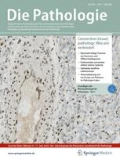Zusammenfassung
Die perkutane Nierenbiopsie stellt derzeit den Goldstandard in der Diagnostik der meisten primären und sekundären Nierenerkrankungen dar. Sie dient der Identifikation und Klassifikation renaler Erkrankungen und ist die Grundlage für die Durchführung standardisierter Therapiekonzepte. Wie bei jeder anderen diagnostischen Technik hängt die Güte der ableitbaren Informationen von der vorhandenen Erfahrung und einer standardisierten Durchführung ab. Für die Nierenbiopsie sind dies v. a. die Gewinnung und adäquate Aufarbeitung von repräsentativem Nierengewebe. Die hierfür notwendigen Vorgehensweisen werden im vorliegenden Artikel genauer dargestellt und diskutiert.
Abstract
A kidney biopsy is an important and frequently used diagnostic tool in routine nephrology. In order to obtain relevant clinical information from a renal biopsy close cooperation between clinicians and pathologists is mandatory. The better the information obtained from nephrologists and the better the understanding by nephrologists and the quality of the kidney biopsy, the more rewarding is the information from pathologists. The following paper will discuss some practical aspects regarding the interaction between nephrology and pathology which may not be known or poorly handled and may thus cause misunderstanding. In order to facilitate interaction between clinicians and pathologists some guidelines concerning the procedure and work-up of routine kidney biopsies have been established and will be discussed in detail.






Literatur
Iverson P, Brun C (1951) Aspiration biopsy of the kidney. Am J Med S 11:324–330
Hergesell O, Felten H, Andrassy K et al (1998) Safety of ultrasound-guided percutaneous renal biopsy-retrospective analysis of 1090 consecutive cases. Nephrol Dial Transplant 13:975–977
Amann K, Haas CS (2006) What you should know about the work-up of a renal biopsy. Nephrol Dial Transplant 21:1157–1161
Furness PN (2000) Acp. Best practice no 160. Renal biopsy specimens. J Clin Pathol 53:433–438
Kashgarian M (2006) The contribution of quantitative techniques including morphometry to renal diagnosis. Ultrastruct Pathol 30:339–343
Caruntu ID, Covic A (2007) Renal corpuscle morphometry with increased reliability and high level of automation. Pathol Res Pract 203:9–20
Lindenmeyer MT, Kretzler M, Boucherot A et al (2007) Interstitial vascular rarefaction and reduced VEGF-A expression in human diabetic nephropathy. J Am Soc Nephrol 18:1765–1776
Schmid H, Boucherot A, Yasuda Y et al (2006) Modular activation of nuclear factor-kappaB transcriptional programs in human diabetic nephropathy. Diabetes 55:2993–3003
Stuht S, Gwinner W, Franz I et al (2007) Lymphatic neoangiogenesis in human renal allografts: results from sequential protocol biopsies. Am J Transplant 7:377–384
Mengel M, Chapman JR, Cosio FG et al (2007) Protocol biopsies in renal transplantation: insights into patient management and pathogenesis. Am J Transplant 7:512–517
Kainz A, Perco P, Mayer B et al (2007) Gene-expression profiles and age of donor kidney biopsies obtained before transplantation distinguish medium term graft function. Transplantation 83:1048–1054
Schmid H, Cohen CD, Henger A et al (2004) Gene expression analysis in renal biopsies. Nephrol Dial Transplant 19:1347–1351
Regele H, Mougenot B, Brown P et al (2000) Report from Pathology Consensus Meeting on Renal Biopsy Handling and Processing, Vienna. http://www.kidney-euract.org/Rbpathology consensus.htm
Thut MP, Uehlinger D, Steiger J, Mihatsch MJ (2002) Renal biopsy: standard procedure of modern nephrology. Ther Umsch 59:110–116
Paone DB, Meyer LE (1981) The effect of biopsy on therapy in renal disease. Arch Intern Med 141:1039–1041
Fuiano G, Mazza G, Comi N et al (2000) Current indications for renal biopsy: a questionnaire-based survey. Am J Kidney Dis 35:448–457
Andreucci VE, Fuiano G, Stanziale P, Andreucci M (1998) Role of renal biopsy in the diagnosis and prognosis of acute renal failure. Kidney Int (Suppl 66):S91–S95
Cameron JS (nd) Indications for Renal biospy, history of the procedure, and relationship of the findings to further investigation and treatment. In: Solez K, Racusen L, Olsen S (eds) Diagnostic Renal Pathology. Transpath Inc. http://www.transpath.com/m-media/DRP.htm
Corwin HL, Schwartz MM, Lewis EJ (1988) The importance of sample size in the interpretation of the renal biopsy. Am J Nephrol 8:85–89
McCarthy GP, Roberts IS (2002) Diagnosis of acute renal allograft rejection: evaluation of the Banff 97 Guidelines for Slide Preparation. Transplantation 73:1518–1521
Hohenstein B, Uder M, Willam C et al (2007) Transvenous renal biopsy of a kidney transplant in a patient with a suspected bleeding disorder. Am J Transplant 7:2052–2053
Nickeleit V, Zeiler M, Gudat F et al (2002) Detection of the complelectron microscopyent degradation product C4d in renal allografts: diagnostic and therapeutic implications. J Am Soc Nephrol 13:242–251
Böhmig GA, Exner M, Habicht A et al (2002) Capillary C4d deposition in kidney allografts: a specific marker of alloantibody-dependent graft injury. J Am Soc Nephrol 13:1091–1099
Fogo A, Hawkins EP, Berry PL et al (1990) Glomerular hypertrophy in minimal change disease predicts subsequent progression to focal glomerular sclerosis. Kidney Int 38:115–123
Amann K (2000) New parameters in kidney biopsy diagnostic-morphometry. Kidney Blood Press Res 23:181–182
Yasuda Y, Cohen CD, Henger A, Kretzler M; European Renal cDNA Bank (ERCB) Consortium (2006) Gene expression profiling analysis in nephrology: towards molecular definition of renal disease. Clin Exp Nephrol 10:91–98
Perco P, Pleban C, Kainz A et al (2006) Protein biomarkers associated with acute renal failure and chronic kidney disease. Eur J Clin Invest 36:753–763
Interessenkonflikt
Keine Angaben
Author information
Authors and Affiliations
Corresponding author
Rights and permissions
About this article
Cite this article
Amann, K., Büttner, M. Beurteilung der Nierenbiopsie. Pathologe 32 (Suppl 2), 361 (2011). https://doi.org/10.1007/s00292-011-1484-5
Published:
DOI: https://doi.org/10.1007/s00292-011-1484-5

